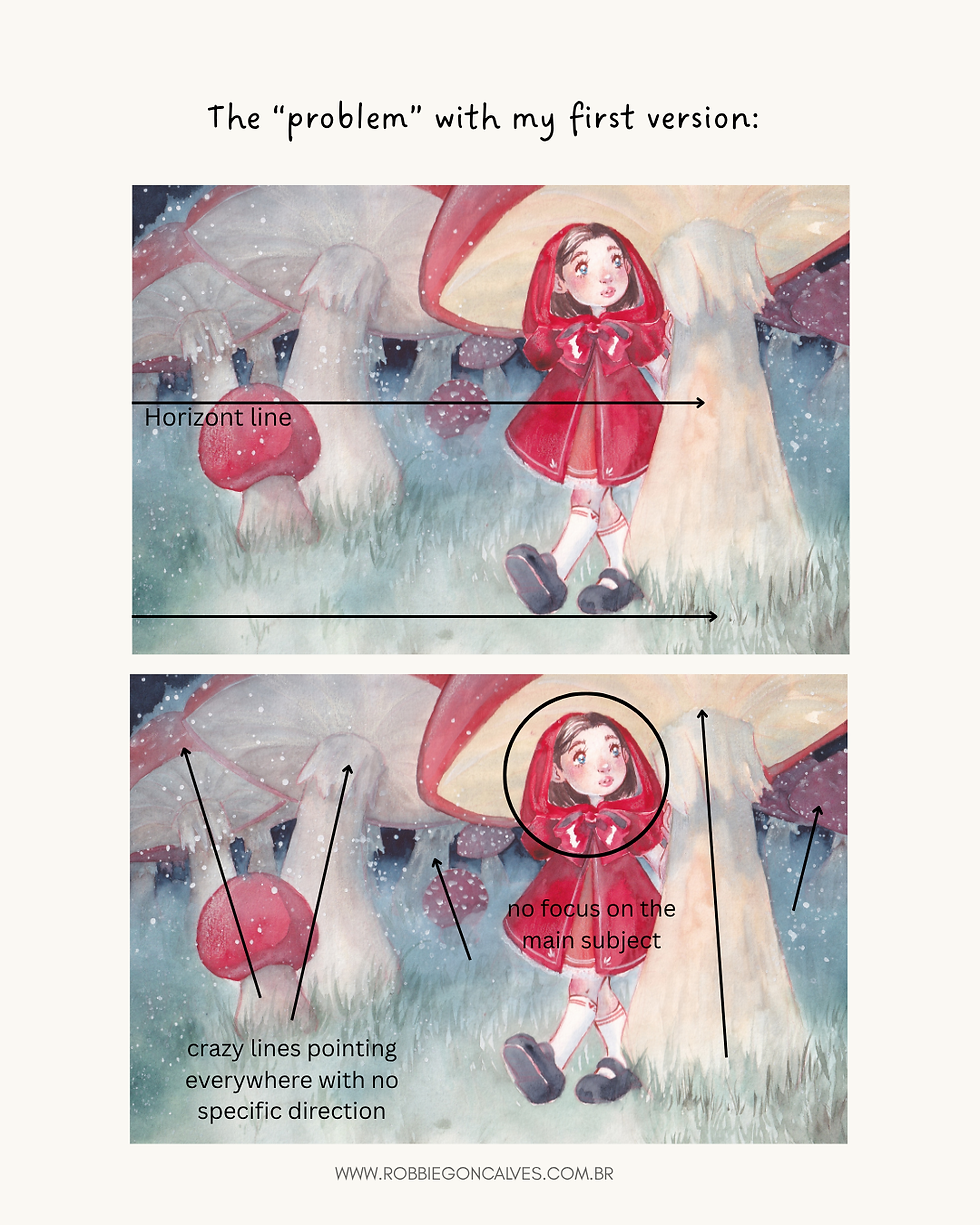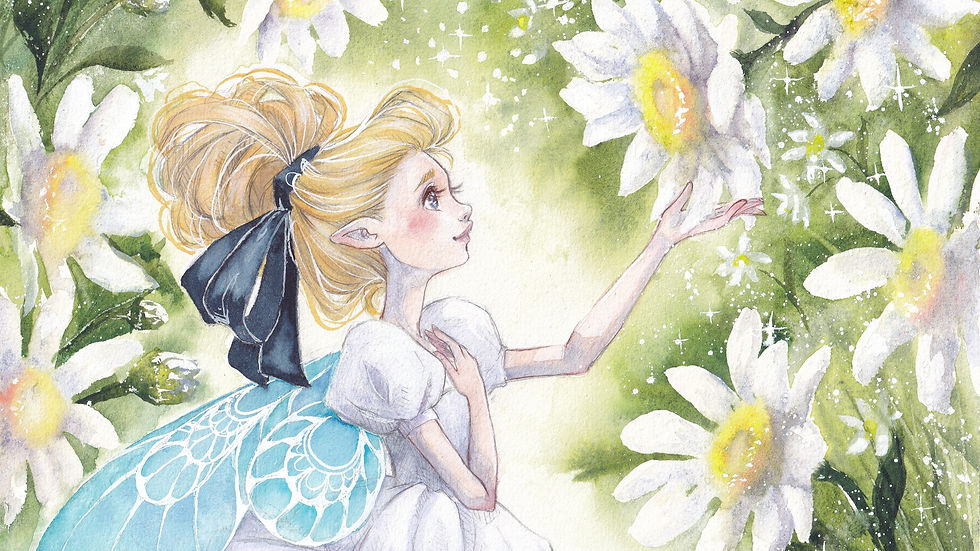COMPOSITION: How it changed my art
- Robbie Gonçalves
- Oct 15
- 5 min read
Updated: Nov 6

“I don’t think this art is bad, but it could be better.” - Rogério Coelho (Mentor)
With this comment he showed me that I HAD to study more the basics of COMPOSITION. And that was the best thing I ever did after years of drawing blindly with just “feelings”.

A few months ago I went to a mentorship with one of the greatest Brazilian authors and Illustrators: Rogério Coelho.
He is the magical mind behind the book "The Dream Boat", "You Be You" (with Richard Brehm), the graphic novel "Louco: Fuga" for the Great Maurício de Sousa studio and uncountable other children's books.
Have someone to tell you what you WANT to hear is nice, but it’s much better if you have someone to tell you what you NEED to hear. That's the importance of showing your art to someone that wants you to be a better artist.
After this mentorship, I began my journey through the Magic World of Composition. It isn't a easy path, but the results were remarkable!
So you have to study the basics if you want to improve your art and you CAN’T run away from this!
Even if you wear the best running shoes, the Basic Drawing Study will find you one day... no matter what...

You can just google “drawing composition tips for beginners” and you will find an infinity number of images and youtube videos explaining all the basic shapes of composition.
Or you can dive deep into the old hard way like I did: BOOKS.
A BRIEF EXPLANATION ABOUT COMPOSITION:
(you can research lots of great videos about it later)
(or you can skip this part and go straight to my art study... its just to make the post a little bit more professional)

THE RULE OF THIRDS: is a composition guideline that divides an image into nine equal parts using two horizontal and two vertical lines. To use it, place your subject along these lines or at the points where they intersect to create a more balanced and visually appealing image.
THE GOLDEN SECTION: The golden section is a principle of composition that uses a specific ratio, approximately 1∶1.6181, to create visually pleasing arrangements.
GOLDEN TRIANGLES: involves dividing a frame into four triangles with diagonal lines, with two lines forming a 90-degree angle at the center of the first diagonal line. It is a technique for creating a more dynamic and visually balanced composition by guiding the viewer's eye, similar to the rule of thirds, by placing key elements along the diagonal lines and at their intersection points.
SPIRAL SECTION: place your main subject or focal point in the tightest part of the spiral, which is the smallest area, to draw the viewer's eye. You can then arrange supporting elements along the rest of the spiral's curve to guide the viewer's gaze through the scene and create a sense of flow and harmony. The spiral can be rotated or flipped to fit the specific subject matter.
GOLDEN SPIRAL: a compositional technique that uses a spiral based on the Fibonacci sequence to guide the viewer's eye to a focal point. To use it, place your main subject in the center of the spiral's smallest part and arrange other supporting elements along the curve of the spiral to lead the eye through the rest of the image. This method helps to create visually balanced and dynamic compositions that feel natural and aesthetically pleasing.

HARMONIOUS TRIANGLES: often called the Golden Triangle, involves dividing a frame into four triangles to create balance and movement. To achieve this, draw one diagonal line from corner to corner, then add two more lines from the remaining corners to the first at 90-degree angles. Place key elements along these lines and distribute visual weight across the triangles to guide the viewer's eye through a dynamic and harmonious composition.
CROSS: or cruciform composition, is an art arrangement where elements form a cross shape, guiding the viewer's eye with a central focal point where a strong vertical and a strong horizontal line intersect. This structure provides balance and is versatile, applicable to landscapes, portraits, and still lifes, and can be either a rigid, symmetrical shape or a looser, off-center guide for placing elements.
FOCAL MASS: is the main area of interest in an artwork, created by a concentration of visual elements like color, shape, or texture that collectively draw the viewer's eye. It is similar to a "group mass," which is a collection of elements treated as a single unit, but the focal mass is typically the most dominant part that stands out and anchors the composition. To compose a focal mass, artists use contrast, placement, and other techniques to emphasize the focal point, which can be supported by subordinate areas of interest to guide the viewer's gaze.
V-ARRANGEMENT: refers to a visual or musical composition technique where elements are arranged in a "V" shape, directing the eye to a focal point or creating a sense of movement and balance.
DIAGONAL: is a technique of arranging elements in an image, such as a photograph or painting, along diagonal lines. This technique is used to create a sense of movement, dynamism, and energy, guiding the viewer's eye through the work and increasing visual tension. It is useful for breaking away from the static nature of vertical and horizontal compositions and can be found in both natural elements (mountains) and architectural elements (edges of buildings, streets).
RADIAL: Visually organizes elements around a central point, like rays extending from a circle, creating a sense of harmony and balance. This technique is used to guide the viewer's eye to the center and can be applied to circular or other shapes, in both symmetrical and asymmetrical arrangements.
L-ARRANGEMENT: in visual art, it is an arrangement of elements in an "L" shape to guide the viewer's eye.
COMPOUND CURVE: is composed of two or more circular arcs of different radii that bend in the same direction and are connected by a common tangent. The compound curve implies motion and rhythm in the painting and is especially good when there are some interceptions of straight verticals such as trees or horizontal lines such as land masses.
PYRAMID: The composition of a pyramid can be understood in two ways: a geometric structure with a base, triangular faces, and an apex, or the materials used to build ancient structures like those in Egypt and Mesoamerica.

CIRCULAR: or "tondo," is an art arrangement that uses a circular format to create a harmonious and unified piece. Unlike rectangular formats, it relies on a rhythmic, circular flow that guides the viewer's eye and can be used to simplify complex scenes or create a sense of unity. Key tips for composing a tondo include placing the focal point off-center and ensuring all sides are considered equally due to the lack of horizontal or vertical energy.

STUDYING MY ILLUSTRATION:

But Robbie, how to use the Magic of Composition to fix it?
It's simple:

Well... not that hard, Mr. Miyazaki, not that hard!
There's NO secret formula. You have to practice and draw and draw and draw. Test all types of composition. Study! It's up to YOU.
You have to draw until you find what you're looking for. You have to make it flow through your veins and make it something natural and automatic to you. That's the formula.
You have to train your brain to see the Composition Rules automatically.
And the only way to do that is through PRACTICE!
Yeah, life isn't easy. If you want to be a better illustrator, you have to work hard!

In 99,9% of the illustrations, a good coloring and drawing can be destroyed by a bad composition.

So, that's it.
Thank you for reading. See you next time.
Love,
Robbie.
Here is a list of the best websites and blogs to study composition:
Painting Lessons with Marla Baggetta: https://paintinglessonswithmarla.com/128-composing-in-the-middle/
Samuel EarpLandscape Artist & Art Coach: https://samuelearp.com/blog/composition-ideas/
https://www.workovereasy.com/2019/06/13/a-beginners-guide-to-composition/
https://monalisa.org/2012/09/12/leonardo-and-mathematics-in-his-paintings/
My Top 10 Composition Tips for artists: https://www.youtube.com/watch?v=JuEkb6FNptE
6 EASY Rules for Better Composition and Better Art : https://www.youtube.com/watch?v=XQrEpYBg0c4
The Silver Way: Techniques, Tips, and Tutorials for Effective Character Design: https://www.amazon.com.br/Silver-Way-Techniques-Tutorials-Effective/dp/1624650341


Comments